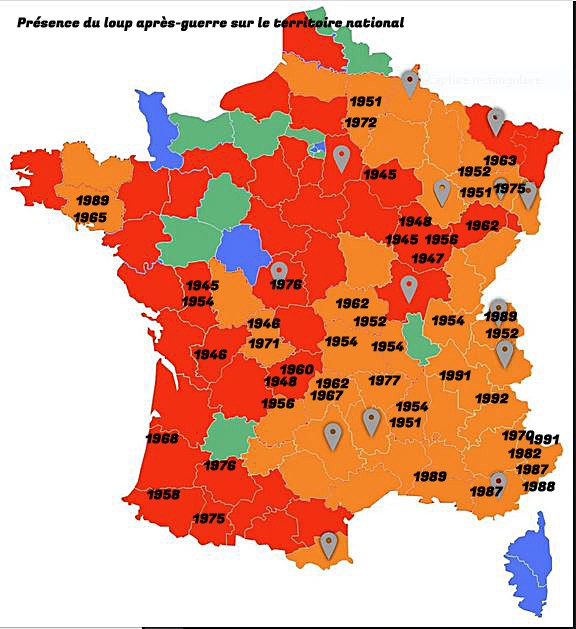It has been confirmed! An animal seen in Calvados, France was a male wolf. They have not been seen in this part of France for over 100 years.

This map shows 2 things. The dates are the last sighting of wolves before they were locally eradicated (as you can see, a France fully devoid of wolves is a recent invention). The orange areas are those where wolves have been sighted in recent years.
As you can see, the wolf is now widespread across France. However, most of these sightings will have been lone dispersing males. As of the beginning of this year, there were roughly 620 wolves in France. While individuals have roamed far and wide, the majority live in the Alps region.
Wolves are not to be feared, as they are highly unlikely to attack humans. Indeed, their presence is likely to save lives. This is because their presence means that deer cross roads far less often. 70% of collisions with animals are with deer, with a further 24% with boar (the boar population has quintupled in the last 20 years).
The recovery of the wolf would likely reduce this number, and indeed generally wolves save more money in prevented crashes, than they cost in livestock attacks. This of course assumes that people take precautions, including guard dogs among others. Predation of livestock will never be eliminated if predators run free. It can, however, be reduced to a rare occurrence. On the other hand, the presence of wolves makes the whole ecosystem more healthy – indeed crops will face less browsing herbivores
While most of the sightings of wolves in France, outside the area close to Italy, are individuals, as wolves travel to these areas more often they will slowly settle. Indeed, if on one of their wonderings, one of these lone males came across a dispersing female, they would likely form a breeding pack.
Wolves are an important part of the European wildlife, and I hope that France does not change its outlook. France is capable of supporting many times more wolves than it currently does – hunting quotas must allow the population to grow over time. One thing to note, is that it seems that growth is being underestimated. back in 2018 there was a plan to allow the wolf population to grow by 40% over the 5 years to 2023, to a total of 500. Yet given the current population is more than 600, clearly this was too pessimistic.
There is thought to be one pack that has migrated to the Pyrenees. This pack has come from France rather than from Spain. Spain does indeed have its own population of wolves (we have talked about that in the past) that currently numbers roughly 2500. These are restricted to the north west of the country, so as yet there is little potential of Iberian wolves meeting with the Apennine wolves spreading across France – having said that, it seems only a matter of time before the disparate wolf populations of Europe start to reconnect.











